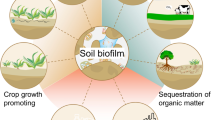Abstract
Concentrations in air of (Z)-9-tetradecen-1-ol formate (Z-9-tdf), a mating disruptant ofHeliothis moths, were measured intermittently over a 22-day period in a corn field. The chemical was emitted from laminated plastic (Hercon®) dispensers arranged in a square grid with 10-m spacing. Measurements were made at three heights near the center of the treated plot and 1 m downwind from disruptant dispensers. Concurrent measurements were made of wind speed, air temperature, and temperature gradient.Z-9-tdf concentrations ranged from below detectable levels to 195 ng/m3 and were generally highest in the horizontal plane of the dispenser. As wind speed decreased near sunset, concentrations increased sharply, then decreased again near midnight. SinceHeliothis moths mate in the evening and early night, the concentration pattern was favorable for mating disruption. Strong temperature inversions within the crop canopy, which occurred daily before sunset, did not apparently affectZ-9-tdf concentrations. Concentrations decreased steadily on successive sampling days after application, and, by day 27, ranged from 0 to 30% of those on day 6. The data suggest that the corn plants and the soil may act as sinks for the chemical vapor at night.
Similar content being viewed by others
References
Cardé, R.T. 1976. Utilization of pheromones in the population management of moth pests.Environ. Health Perspect. 14:133–144.
Card, J.H., Bierl, B.A., Freeman, H.P., andSonnet, P.E. 1978. A method for trapping disparlure from air and its determination by electron-capture gas chromatography.J. Agric. Food Chem. 26:461–463.
Caro, J.H., Freeman, H.P., andBierl-Leonhardt, B.A. 1979. Determination of (Z)-9-tetradecen-1-ol formate, aHeliothis spp. mating disruptant, in air by electron-capture gas chromatography following photolytic cleanup.J. Agric. Food Chem. 27:1211–1215.
Hendricks, D.E., andTumlinson, J.H. 1974. A field cage bioassay system for testing candidate sex pheromones of the tobacco budworm.Ann. Entomol. Soc. Am. 67:547–552.
McDonough, L.M. 1978. Insect sex pheromones: importance and determination of half-life in evaluating formulations. USDA Agric. Res. Results ARR-W-1, 20 p.
Mitchell, E.R., Baumhover, A.H., andJacobson, M. 1976. Reduction of mating potential of maleHeliothis spp. andSpodoptera frugiperda in field plots treated with disruptants.Environ. Entomol. 5:484–486.
Munn, R.E. 1966. Descriptive Micrometeorology. Academic Press, New York. 245 pp.
Plimmer, J.R., Bierl, B.A., Webb, R.E., and Schwalbe, C.P. 1977. Controlled release of pheromone in the gypsy moth program, pp. 168–183,in H.B. Scher (ed.). Controlled Release Pesticides. ACS Sympos. Ser. 53, American Chemical Society, Washington, D.C.
Roome, R.E. 1975. Activity of adultHeliothis armigera (Hb) (Lepidoptera, Noctuidae) with reference to the flowering of sorghum and maize in Botswana.Bull. Entomol. Res. 65:523–530.
Author information
Authors and Affiliations
Rights and permissions
About this article
Cite this article
Caro, J.H., Glotfelty, D.E. & Freeman, H.P. (Z)-9-tetradecen-1-OL formate. J Chem Ecol 6, 229–239 (1980). https://doi.org/10.1007/BF00987542
Received:
Revised:
Issue Date:
DOI: https://doi.org/10.1007/BF00987542




